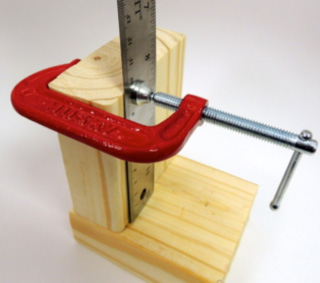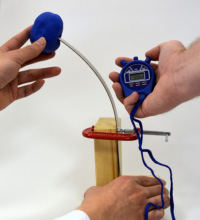Earthquakes and Resonance
|
This activity created in partnership with AGI.
The crust of the Earth is made up of plates that are in constant—though very slow—motion along faults in the lithosphere. There are also faults within the plates, not associated with the plate boundaries. Sometimes faults get stuck and stress builds up. That stress gets released with a sudden jerky and irregular movement of the rock on either side of the fault, causing strong vibrations. The vibrations travel away from the fault in the form of seismic waves. Above the fault, the vibrations cause up-and-down motions and side-to-side motions of the ground surface. That movement is an earthquake.
|
Aerial view of San Andreas fault. |
Earthquakes vary greatly in their strength. Most earthquakes are so small that they can be detected only with special instruments. Some earthquakes, however, release an enormous amount of energy. They can cause ground motions so strong that people who are out in the open can’t even stand up!
The most serious hazard associated with earthquakes is the destruction of buildings. Many structures cannot withstand the prolonged shaking of the ground during an earthquake. As a result, they may collapse or tip over and fall onto neighboring structures. Collapsing or falling buildings are responsible for many earthquake-related deaths.
One type of damage that can occur during an earthquake is related to the height of a building. All buildings have a natural oscillation period—the time it takes for the building to sway back and forth one time. The oscillation period depends on the size and shape of the building. Generally, taller buildings have longer periods of oscillation than shorter buildings. If the natural oscillation of a building has the same period of oscillation as the back-and-forth shaking of the ground during an earthquake, then the building’s sway will be greater. This is called resonance. This increases the probability that the building will collapse. If the ground oscillation is either more rapid or slower than a building’s natural oscillation, then the building will be less affected.
|
Partially collapsed 15-story high-rise building in Taichung. |
Our Experiment
In this activity, you will calculate the natural oscillation period of an object. You will use your findings to explore the relationship between height and stability of a structure during an earthquake. We suggest that you work in groups of two or three on this activity.
Tools and materials
- Two square pieces of wood measuring about 10 cm (4 in) across
- 30-cm-long (12-in) thin metal strip—we used a thin metal ruler
- Small C-clamp
- Lump of modeling clay, approximately half the size of a fist, about 100 g (3.5 oz)
- Ruler or meter stick
- Hammer and nails, or screwdriver and screws, for wood
- Stopwatch or timer
- Safety goggles
What to do
Note: Please wear safety goggles during this activity while constructing your model and performing the activity.
|
|||||||||||
|
|||||||||||
|
|||||||||||
|
|||||||||||
|
|||||||||||
|
|
|
 |
Digging DeeperFind out more about |
|
|
|
This content has been re-published with permission from SEED. Copyright © 2025 Schlumberger Excellence in Education Development (SEED), Inc.
Course:










